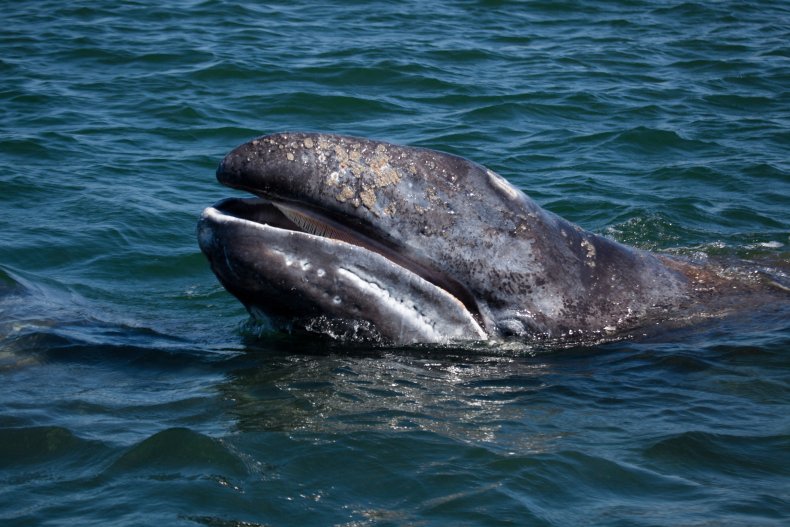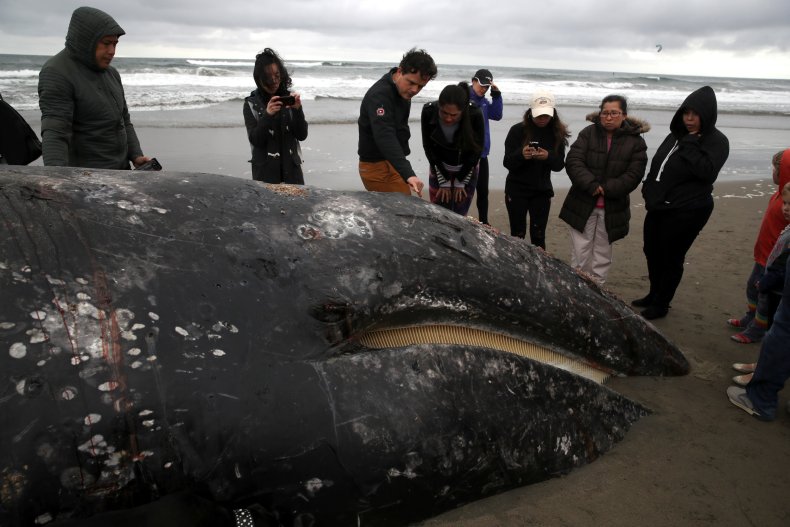A gray whale that washed up dead and covered in tooth marks on a beach in Northern California may have been involved in a recent attack by orcas.
The 28-foot gray whale was discovered on a beach at Point St. George, near Crescent City on April 18. Dawn Goley, director of Cal Poly’s Marine Mammal Stranding Program, and her students attended the carcass and found that the whale was emaciated and likely a juvenile. None of the tooth marks were considered life-threatening injuries, local news site Wild Rivers Outpost reported on Thursday, and the whale’s cause of death remains unknown.
This incident came only days after a group aboard a local charter boat, Stella’s Adventures, witnessed a pod of orcas attacking three gray whales very close to the beach where the carcass was found, leading to suspicions that the dead whale may have been involved. One local, Tayler McCann, commented on a picture of the whale on the beach underneath a video of the orca attack.
Gray whales are large whales found across the northern Pacific. They usually grow to between 42 and 49 feet long, according to the National Oceanic and Atmospheric Administration (NOAA), and weigh up to 90,000 pounds. These whales usually migrate up and down the West Coast with the seasons, traveling up to 14,000 miles between Alaska and Mexico for the winter and back again in the summer.

A dead juvenile gray whale lies in the sand on Limantour Beach at Point Reyes National Seashore in Point Reyes Station, California, on May 25, 2019.PHOTO BY JUSTIN SULLIVAN/GETTY IMAGES
While the whale was found on a Point St. George beach, the orca attack was filmed just north of Castle Rock, an island nearby, by people on the Stella’s Adventures boat. On April 15, the passengers saw the orcas attack the three whales, with the juvenile isolated from the two adult whales, as shown in a video uploaded to Facebook by Stella’s Adventures and later by Wild Rivers Outpost.
“Here’s five orcas swimming at 35 m.p.h. straight at these whales,” Crescent City Harbor Commissioner Harry Adams, owner of Stella’s Adventures, told Wild Rivers Outpost. “They’re flying! As soon as they get close, four of them break off and go [for the] calf while the big female goes after the two adults [grays].”
The orcas then drove the juvenile into shallower water before leaving the whales.
Orcas regularly attack gray whales as prey, especially calves, and are the only predator of the whale species, except for humans. Usually, the orcas will attempt to separate the calf from the rest of the whales and hold it beneath the water until it drowns.

A stock image shows a juvenile gray whale in the ocean off Baja California, Mexico. Orcas will often attack juvenile gray whales and try to drown them before preying on them.ISTOCK / GETTY IMAGES PLUS
“It was nonstop,” Adams said of the orca attack on April 15. “They were working [the gray whale] like a Ferris wheel—going around with a different orca every second, flipping it on its back trying to drown it.”
A 2011 study in the journal Science estimates that one-third of gray whale calves may be killed by orca predation each year.
“The big goal is getting the calf away from its mother,” Josh McInnes, an orca researcher from the University of British Columbia’s Marine Mammal Research Unit in Vancouver, told Wild Rivers Outpost.
“We often observe killer whales trying to use their bodies to move calves away,” he said. “They grab onto the tail fluke of calves or their pectoral fins, trying to drag the calf away. Once the calf is separated, killer whales change their behavior to try to wound it. We often see them ramming it.”

People look at a beached gray whale at San Francisco’s Ocean Beach on May 6, 2019.PHOTO BY JUSTIN SULLIVAN/GETTY IMAGES
Orcas also prey on a number of other large marine species, including even great white sharks, which the orcas hunt for their fatty, nutritious liver.
McInnes suggested that the carcass found on Tuesday may have been malnourished already and that the whale died from the stress of the attack.
“By that time, the gray whale had already been injured from the attack, and the killer whales abandoned the hunt and the gray whale died of its injuries and washed up on shore,” he said.
“If an animal is already emaciated—and we do see this in gray whales—we don’t see wounds that kill the animal. But if it’s already emaciated and super stressed, we don’t know, but [the attack] could cause some sort of adverse reaction the animal could die of,” McInnes said.
The exact cause of the whale’s death can be revealed only after a necropsy of the body, which, according to Wild Rivers Outpost, was left on the beach to return to the elements.
Gray whales have washed up after orca attacks before, and there has also been a spate of mysterious gray whale deaths along the west coast of the U.S., Canada and Mexico over the past few years.

An NOAA Fisheries graph shows gray whale strandings across the U.S., Mexico and Canada since 2015.NOAA FISHERIES: 2019-2023 GRAY WHALE UNUSUAL MORTALITY EVENT ALONG THE WEST COAST AND ALASKA
NOAA data shows that in 2019 there were 216 gray whale deaths along the west coast from Alaska to Mexico, with 172 in 2020 and 115 in 2021. In 2022, NOAA recorded 15 gray whale strandings in Washington alone, with a total of 47 on the U.S. West Coast. NOAA has declared this an Unusual Mortality Event, but the driving factors behind it are still unclear.
“While the full reasons behind the Unusual Mortality Event are not understood, it does appear to be related to an increase in the gray whale population prior to the event and a decreased availability of prey, creating nutritional deficiencies in a portion of the population,” John Calambokidis, a research biologist at the Cascadia Research Collective, previously told.








